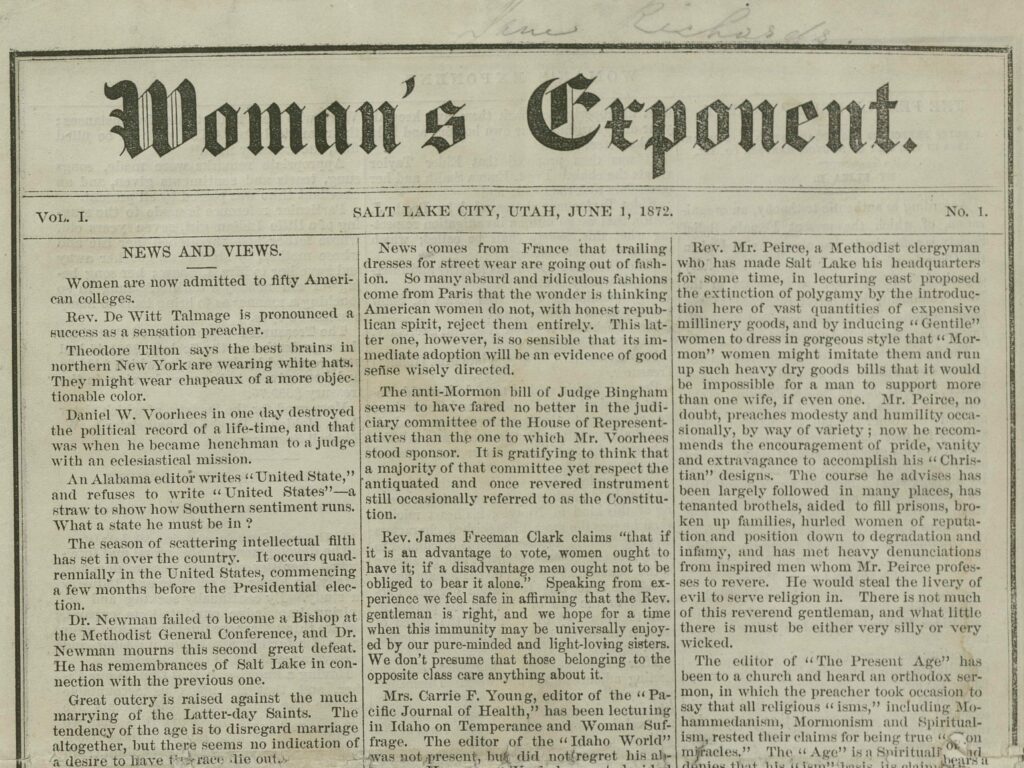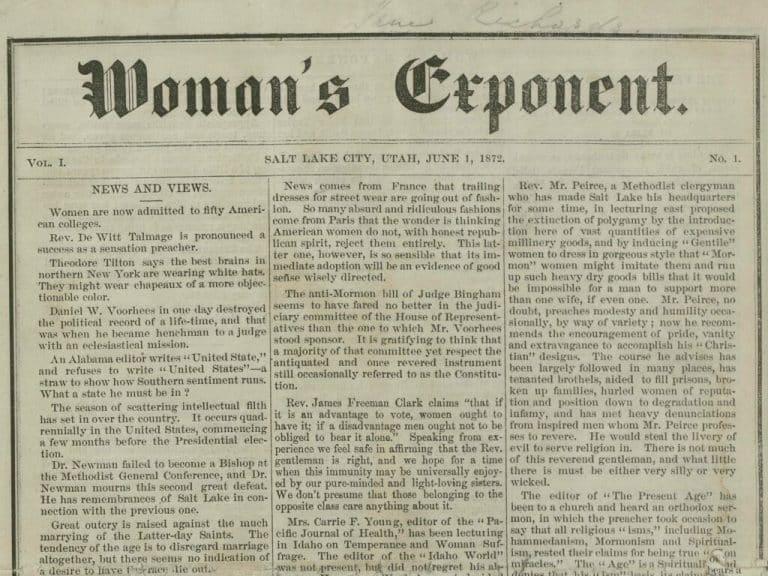By Lori LeVar Pierce, president of Exponent II

On June 1, 1872, the first edition of The Woman’s Exponent was printed. For 42 years, this semi-monthly publication shared the voices of Women in The Church of Jesus Christ of Latter-day Saints in its mission to “discuss every subject interesting and valuable to women.” Today, we mark 150 years since its commencement. With the lack of female voices in our historical records (including scriptures), it is really remarkable to have this treasure trove of women’s voices sharing their opinions, their stories, and their poetry. It was the discovery of the archives of this newspaper that was the inspiration for creating the Exponent II organization, with an accompanying newspaper, in 1974.
The Woman’s Exponent began with Louisa Lula Greene Richards serving as https://exponentii.org/wp-content/uploads/2021/12/IMG_5173-scaled-2.jpg. Louisa was a grand-niece to Brigham Young and sought his advice before beginning. According to a history published in the May, 1912 edition, Brigham gathered leading women, including Eliza R. Snow, to conference about the prospective newspaper and Brigham gave Louisa the assignment of publishing the newspaper as a mission. When Greene married in 1874, she took on an assistant https://exponentii.org/wp-content/uploads/2021/12/IMG_5173-scaled-2.jpg, Emmaline B. Wells, who was then the https://exponentii.org/wp-content/uploads/2021/12/IMG_5173-scaled-2.jpg-in-chief from 1877 to 1914.
The Woman’s Exponent covered topics such as local and general news, educational matters, health and dress, household topics, and correspondence and https://exponentii.org/wp-content/uploads/2021/12/IMG_5173-scaled-2.jpgials on leading topics of interest such as suffrage for women and polygamy. The Woman’s Exponent celebrated the work of other women. Exponent II tried to follow that same pattern as we celebrate women’s accomplishments in our monthly newsletter.
The first edition of The Woman’s Exponent covered news of the day. For example: women being admitted to 50 colleges; that it was the first time since the first order of succession that both houses of the U.S. Congress had their full list of members; that in France, trailing dresses for streetwear were going out of fashion; and that Susan B. Anthony spoke to the Cincinnati Convention on the topic of women’s suffrage. There was a call for women to continue to seek and acquire knowledge, as well as a history of the Relief Society and a report of current RS activities. Household hints, such as how to make buckwheat cakes, how to remove offensive breath, cure asthma, or clean hair were provided along with advice for how to avoid being a careless wife.
Most print editions were 8 pages in length and a subscription cost $2 a year. When it began, The Woman’s Exponent was only the second women’s paper published west of the Mississippi. In 1912, it was the second oldest women’s paper in the entire United States. There were a number of different locations for the headquarters of The Woman’s Exponent, but it was always housed at the Relief Society headquarters and was considered the work of the Relief Society. In October of 2020, the LDS Church News did a feature article on The Woman’s Exponent, noting its importance in elevating the voices of women.
When I became the President of the Exponent II organization earlier this year, I wanted to take some time to learn more about The Woman’s Exponent. After listening to a recent panel discussion held at the University of Utah, I took time to read through many editions of The Woman’s Exponent and am really impressed that this publication, an official arm of the Relief Society organization, printed some very forthright commentary on the necessity of equality for women in things like voting rights, education, and opportunities for employment. It is true that one of the primary purposes of this paper was to present LDS women engaged in polygamy as normal and not oppressed to the outside world, yet the latitude given them to print their https://exponentii.org/wp-content/uploads/2021/12/IMG_5173-scaled-2.jpgials and opinion pieces about female equality was a little surprising to me. I don’t think we would see the same kind of freedom today to even speak up this way in our congregations, much less publish an opinion piece on women’s rights for worldwide distribution endorsed by the church.
I admit to a bit of surprise at finding articles in the first edition as varied as “Women’s Rights and Wrong” and “Hints to Careless Wives.” I’m not sure how many publications in today’s world would include in a single issue commentary, such as:
- “How utterly is the peace of mind and comfort of many husbands ruined by the carelessness and untidiness of their wives! Let the wife reflect that upon her conduct and disposition depend the happiness of a man’s home-life.”
- “The agitation of the women’s rights question aims at obtaining a broader recognition for the rights of women, now deprived of many privileges it is contended they should enjoy, and refused rights which it is claimed they should possess equally with men… She should have access to every avenue of employment for which she has physical and mental capacity….She should not be held more responsible than man – if as much – for sexual crime…The elective franchise is enjoyed by many foreign born citizens…millions of intelligent native-born women are deprived of it, simply because nature qualified them to become mothers and not fathers of men.”
While it is true that the voices of many women were left out, particularly marginalized women, it is still remarkable that we have 42 years of these women’s voices in print. The Exponent II magazine has highlighted original Women’s Exponent writings paired with Exponent II content in our Generations series.
To honor the contributions of these female writers, we invite guest posts on articles from The Woman’s Exponent. Every edition has been digitized and is available to read online at the University of Utah online library, The BYU online library, and the Church History online collection. Pick an edition or two (or three or ten) and see if a particular article strikes a chord with you. Perhaps it did or did not age well. Perhaps there are opinions on women’s equality that need to be heard again. Perhaps taking an article and adding historical content would make it a more interesting read. Whatever motivates you, we want to provide an avenue to elevate the voices of these women who lived in Utah between 1872 and 1914. Submit your guest post here.


